Pla Ra: Thai Fermented Fish
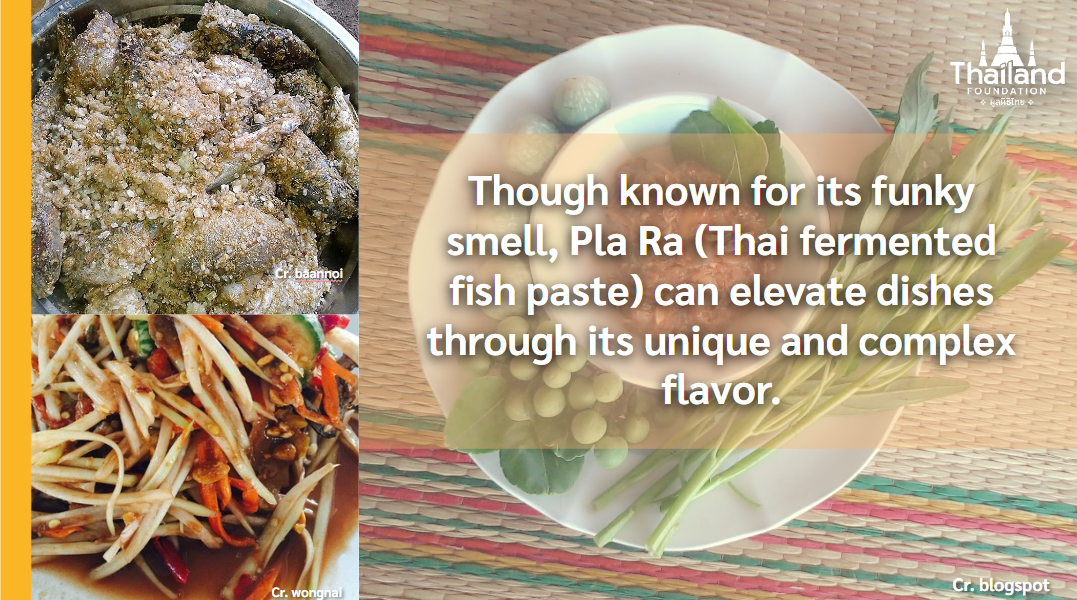
Various delicacies in the world owe their unique, complex flavors to different fermented ingredients. These ranges from European’s sauerkraut to sourdough bread, and from the fiery taste of kimchi in numerous Korean dishes to the umami flavor of miso in Japanese cuisine. Thai food is no different. While Thai cuisine has gained global recognition for its rich flavors and unique culinary techniques, the secret behind exceptional flavors of many dishes remains relatively unknown to many. The hidden gem of Thai ingredient is fermented fish, or pla ra which does not only enhance the umami taste of food but is also nutritious. Join us on a delectable journey as we uncover the story of pla ra and its indispensable role in Thai cuisine.
What is pla ra?
Pla ra (ปลาร้า), sometimes called pla daek (ปลาแดก) in some Northeastern provinces, is a type of fermented fish used in Thai cuisine. It is an ingredient included in most dishes in the Northeast region of Thailand, or Isan. This ingredient is made by fermenting freshwater fish, such as gourami, snakehead, catfish, or small fishes, with salt and rice bran or roasted rice powder in a closed container for at least six months.
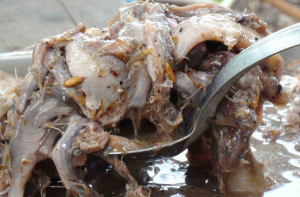
Pla ra (ปลาร้า) or pla daek (ปลาแดก) (Cr. esan-food.blogspot)
Pla ra has a reputation for its strong smell and a salty, umami flavor. Some may view the ingredient as an acquired taste and may be hesitant to try dishes containing pla ra. Yet, pla ra is loved by many Thais and is frequently used as a condiment, enhancing the taste of numerous dishes.
History of Pla Ra
Fermented food has been an integral part of the cuisine in ASEAN countries for more than 3,000 years. These include not just pla ra, but also salted fish, shrimp paste, and fish paste, among others. These ingredients should not be viewed as a creation of a specific country or group of people, but they are the product of a shared culture and culinary wisdom of Southeast Asia when it comes to food preservation techniques. Fermented fish like pla ra is considered a staple food across ASEAN countries. For instance, it is known as pla deak in Laos, prahok in Cambodia, bagoong in the Philippine-s, mam in Vietnam, and pekasam in Malaysia. However, fermented fish in each country is made with different techniques, offering a unique taste and texture.
Pla ra is deeply rooted in the Thai culinary tradition. The practice of fermenting fish in Thailand and the evidence that Thai people commonly consumed pla ra is already present in the era of the Ayutthaya Kingdom (1351-1767). Simon de la Loubère, a French diplomat in the reign of Louis XIV, came to Thailand, previously called Siam, in 1687 and documented what he had observed and experienced during his 3-month stay. In his document, Du Royaume de Siam, La Loubère also wrote about Thai cuisine. He stated that people in the Ayutthaya Kingdom tended to eat rice and fish, especially salted fish and dried fish. There is also a section in the document about fish fermentation in earthen jars or clay pots which indicates that Thai people have been making and eating pla ra even before the time La Loubère arrived, which was more than 330 years ago. Interestingly, he also brought a jar of pla ra back to France.
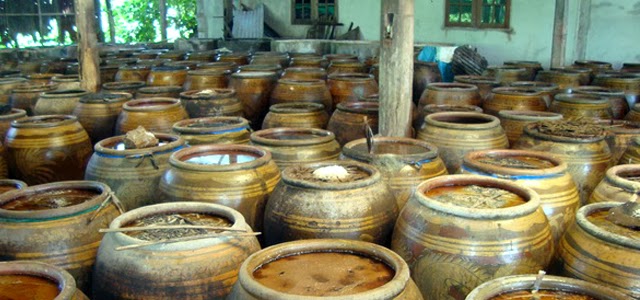
Fermenting fish in jars (Cr. paidooo)
Although having been a part of Thai cuisine from the start, the popularity of pla ra in Thailand never really ceases. Because of its strong umami profile that brings out the complex flavor in each dish, Thai people still incorporate pla ra in their cuisine. In the Northeastern region, pla ra is an ingredient in almost every dish. As people from Isan began migrating to other regions to find jobs, Northeastern Thai cuisine became more widespread and popular. Dishes containing pla ra, such as som tam (spicy green papaya salad), captured the heart of people from other regions. Some restaurants offer pla ra sauce or pla ra dip as a choice for their consumers or even create a fusion cuisine with it. Some, however, may consider the ingredient as an acquired taste. Therefore, some customers may ask the restaurant, especially ones that sells Isan food, not to add pla ra in the dish.
Regional Variations
Although it is most often associated with Lao and Northeastern Thai foods, pla ra is consumed in every part of Thailand. Different regions of Thailand have their own unique variations of pla ra.
In the Northeastern region, pla ra is a staple ingredient in many dishes such as som tam pla ra (spicy green papaya salad with added pla ra sauce). Moreover, pla ra is sometimes eaten as fried fermented fish or eaten raw with sticky rice. As for the fermentation process, they often ferment freshwater fish with salt and rice bran which gives the fish a reddish pink color and clear black sauce when it is properly fermented. The meat of the fish is often firm, and the smell is quite strong. In this region, pla ra is also divided into categories according to its flavor and smell.
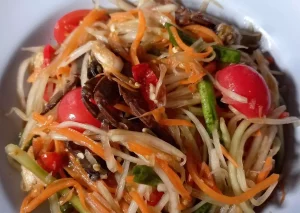
Som tam pla ra (Cr. cookpad)
- Pla ra hom (ปลาร้าหอม) or “fragrant pla ra”
Made by fermenting large fish such as snakehead fish, this type of pla ra gives an aromatic smell and flavorful taste. The meat is reddish pink in color. This method uses more salt than other types of pla ra and the fermentation process takes around six to ten months to finish.
- Pla ra nua(ปลาร้านัว) or “pla ra with umami flavor”
Pla ra nua is made from small-sized to medium-sized fish. The fish is fermented with salt and rice bran in a 4:1:1 ratio for around four to six months. The finished product gives out a gentler scent than pla ra hom.
- Pla ra nong (ปลาร้าโหน่ง) or “smelly pla ra”
The sauce of this type of pla ra is usually used as an ingredient in other dishes and the meat is not eaten raw. It is made from minnow, a range of species of small freshwater fish. This method uses four parts of fish and one part of salt and rice bran fermented for more than ten months to around one year. The result is dark color sauce and meat and the smell of it is pungent and considered the strongest of all three types.
In the Central region, pla ra is often fermented with roasted rice powder instead of rice bran, which makes it yellow with a soft texture. The smell is distinctively aromatic. People in this region often use large-sized fish such as snakehead or climbing gourami as an ingredient for their pla ra since they like to consume it as chunks in a chili paste with multiple vegetables.
As for the Northern region, the locals call fermented fish pla ha (ปลาฮ้า). They use both large-sized fish and smaller ones to make this dish. What is unique is that traditionally they ferment the ingredients, including fish, salt, and roasted rice, in a bamboo tube instead of using an earthen jar. Sometimes they also sun-dry the fish marinated with salt and roasted rice to eat with rice, or they may pound dried pla ha into powder to use as seasoning.
The Southern region also has a unique technique of making their own pla ra or what they call pla ra lae sarb (ปลาร้าเลสาบ), or “pla ra from a lake”. It is often produced in the Songkla Lake area by fermenting catfish with salt and jaggery for a night, then drying it in the sun for two to three days before eating. This method takes the least time of all pla ra in Thailand.
Nutrition
Not only does pla ra help enhance the flavor of multiple Thai dishes, but it also offers a variety of nutrients that contribute to a balanced diet. Moreover, compared to other fermented aquatic products such as fish sauce or kapi (shrimp paste), pla ra is found to be more nutritious. A sample of 100 grams of pla ra, including the meat of fermented fish and its sauce, is estimated to be up to 149 kcal. It contains around 15 grams of protein, 4 grams of carbohydrates, and 8 grams of fat. There are also various vitamins and minerals beneficial to our health such as vitamin A, vitamin B1, vitamin B2, vitamin B3 (niacin), phosphorus, and calcium. Moreover, it is a source of probiotics. Pla ra from a snakehead fish is found to be one of the most nutritious as it is rich in protein and contains less fat. In the Northeastern region, pla ra can be an important source of protein and sodium, helping to prevent diseases related to malnutrition.
While pla ra offers several nutritional advantages, it is worth noting that the traditional one is also high in sodium due to the fermentation process. However, nowadays, there are also many bottled pla ra products containing low sodium in the market. Therefore, those who need to restrict their sodium intake should aim for those products instead.
As with any food, balance and moderation are key. Incorporating pla ra in moderate amounts as part of a balanced diet can provide a unique flavor profile while contributing to a range of essential nutrients.
Cooking with pla ra
Because of the umami taste of pla ra that can add depth of flavor to a dish, it became one of the most popular ingredients in Thai cuisine. Yet, as it is a fermented food, there is a chance of contamination such as liver flukes. Therefore, there are a few steps to follow to cook with pla ra safely. First of all, one needs to buy pla ra from a reliable source to ensure the quality and cleanliness of fermented fish. Then, every time before consuming or adding pla ra to a dish, one needs to boil it at around 90 degrees Celsius for 5 minutes to kill off liver flukes and other bacteria. It should be noted that most pla ra sold in a bottle in a supermarket is already cooked or pasteurized, but one should also choose a brand that has gotten approval from the Thai Food and Drug Administration and check for its expiration date. Lastly, one should not consume pla ra more than two tablespoons per day as it contains high sodium.
Many simple and delicious dishes contain pla ra. Here are some examples:
- Lon pla ra (หลนปลาร้า) or “spicy coconut stew with pla ra”
Lon is a verb meaning simmer or stew. Therefore, this dish is a coconut stew that integrates pla ra in it. To make lon pla ra, one needs to boil coconut milk with a little bit of water. Then, when the coconut milk starts to boil, add the herb, namely, lemongrass, shallots, galangal, and Chinese ginger, followed by tamarind paste. After that, boil the soup over medium heat and then add cooked pla ra sauce to enhance the flavor. As the stew starts boiling again, catfish should be added. However, the fish should not be stirred, instead, one should use a ladle to submerge it in the stew and let it boil for a while. Then, add some bamboo shoots and let it cook before adding yard long beans and eggplant. The final step is adding kaffir lime leaves and red, yellow, and green chili as well as bird’s eye chili for spice. Let it simmer and then a spicy dish to brighten up the day is ready to be served.
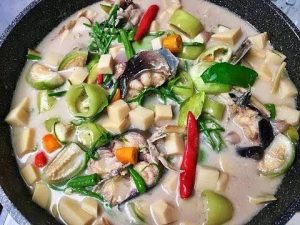
Lon pla ra (Cr. howtocookhub)
- Pla ra bong (ปลาร้าบอง)/jaew bong (แจ่วบอง) or “chili paste with minced pla ra meat”
Another simple but delicious dish that contains pla ra is pla ra bong or sometimes called jaew bong. It is a sweet and savory chili paste originating from Luang Prabang, Laos. Still, this dish is also commonly consumed in the Northeastern region of Thailand by dipping sticky rice or vegetables in it. Pla ra bong is very easy to make, using only common ingredients found in Thai kitchens. First, one has to roast pounded galangal and lemongrass in the pan over medium heat until it is dried and gives out an aromatic smell. Secondly, add minced shallots and minced garlic and stir until all ingredients are completely dried. For the third step, add minced pla ra meat and tamarind paste and stir until everything is mixed and become completely dry. Then, season with sugar, chili powder, and MSG (this is optional). Finally, add chopped kaffir lime leaves and mix well.
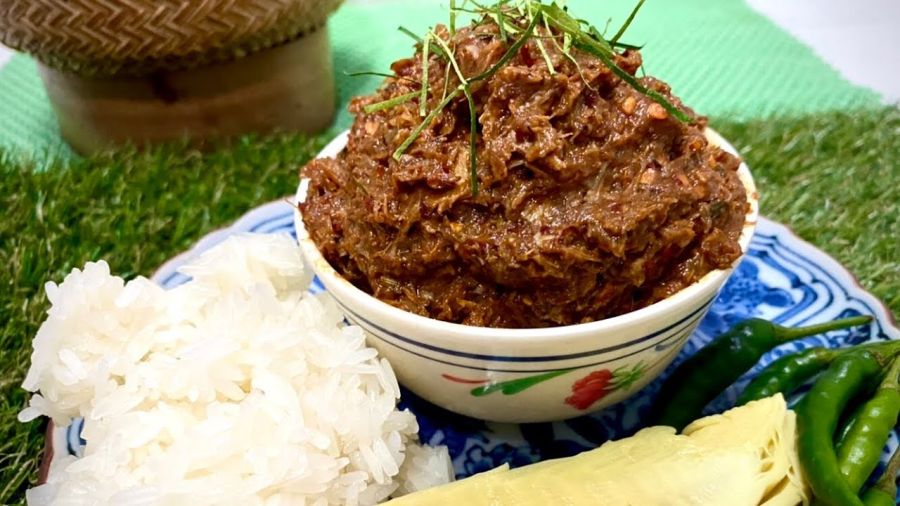
pla ra bong or jaew bong (Cr. board.postjung)
- Kaeng om (แกงอ่อม) or “spicy soup containing vegetables and meat”.
Kaeng om is a soup that has little liquid but is filled with various vegetables and herbs with dill as a main ingredient. Rich flavors from vegetables combined with curry paste create an umami flavor for the soup. In addition to a wide range of herbs, kaeng om also contains some meat, contributing to a more balanced diet. The most popular ones are pork, beef, chicken, and catfish. Pla ra sauce is commonly added as a flavor enhancer. To cook kaeng om, one has to prepare the meat by cutting it into bite-size pieces and pounding dried red chili and shallots until they are crushed to get the curry paste. When the ingredients are ready, boil some water with sliced lemongrass, then add the curry paste. After a while, add chicken, then wait for the water to boil again. The next step is adding vegetables such as dill, cabbage, Chinese cabbage, and spring onion. Finally, season with pla ra sauce and fish sauce as desired, wait for the vegetable to be cooked, and it is ready to be served.

Kaeng om (Cr. ครัวบ้านๆ Channel)
For those interested in Thai culture and cuisine, trying pla ra can be an intriguing culinary adventure. While its pungency might initially seem overpowering, many Thai dishes skillfully balance the flavors, resulting in delightful creations. Thus, pla ra should not be viewed as a funky, scary ingredient to be avoided, but rather a “hidden gem” enhancer that can add great depth and complexity to your meals.
Conclusion
Pla ra showcases the long-standing heritage of food preservation in Thailand. It reflects the creative nature of Thai people who explore and always make the most out of their local resources by creating different ingredients with various flavors from the same source. Pla ra has been a component in Thai cuisine for ages, and, for some, it might be difficult to cook with such a pungent ingredient. Thai people, however, demonstrate their culinary expertise by incorporating the unique, umami flavor of pla ra into their dishes. And whether it is used as a condiment, flavor enhancer, or even the star ingredient, pla ra adds an unmistakable and unforgettable touch to Thai dishes, leaving a lasting impression on those willing to explore Thai cuisine.
The story of “pla ra” is a flavorful part of Thai culture and heritage. We saw the resourcefulness and culinary skill of Thai people are reflected in this local ingredient. Join us in exploring more stories of Thailand and the Thai people, as we take you on a journey to discover Thainess.
Sources
- https://www.silpa-mag.com/culture/article_20370
- https://readthecloud.co/pickled-fish/
- https://food.trueid.net/detail/ydNGQmG67kZE
- https://kukr.lib.ku.ac.th/kukr_es/BKN_FRPD/search_detail/dowload_digital_file/20007771/134271
- https://www.sanook.com/health/34061/
Author: Thanachporn Varapongsittikul
Editor: Tayud Mongkolrat
22 November 2023


